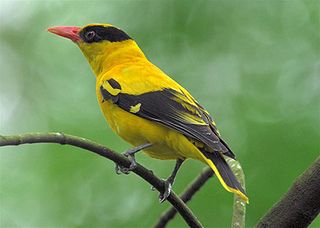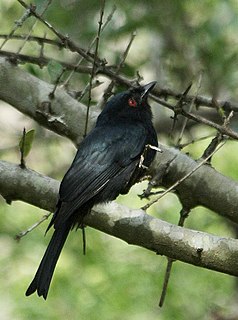
The Old World orioles (Oriolidae) are an Old World family of passerine birds.

The drongos are a family, Dicruridae, of passerine birds of the Old World tropics. The 29 species in the family are placed in a single genus, Dicrurus.

The common square-tailed drongo, formerly the square-tailed drongo, is a passerine bird in the family Dicruridae. It is a common resident breeder in parts of southern Africa.

The figbirds are a genus (Sphecotheres) in the family of Old World orioles found in wooded habitats in Australia, New Guinea and the Lesser Sundas.

The monarchs comprise a family of over 100 passerine birds which includes shrikebills, paradise flycatchers, and magpie-larks.

The silktails are a group of birds endemic to Fiji. The two species are placed in the genus Lamprolia. They look superficially like a diminutive bird-of-paradise but are actually closely related to the fantails.

The pied monarch is a species of bird in the monarch-flycatcher family, Monarchidae. It is endemic to coastal Queensland in Australia.

The drongo fantail, also known as the pygmy drongo, is a species of passerine bird endemic to the island of New Guinea. It is the only species in the genus Chaetorhynchus. The species was long placed within the drongo family Dicruridae, but it differs from others in that family in having twelve rectrices instead of ten. Molecular analysis also supports moving the species out from the drongo family, instead placing it as a sister species to the silktail of Fiji, and both those species in the fantail family Rhipiduridae.

The crow-billed drongo is a species of bird in the family Dicruridae. It is native to moist tropical forests of southeastern Asia where its range extends from India to the Philippines and Indonesia. It is a completely black bird with a shallowly forked tail and is similar in appearance to the black drongo. It breeds between April and June, the cup-shaped nest being built in the fork of a branch by both birds, the female afterwards incubating the eggs. It is a common bird and the IUCN has listed it as "least concern".

Grallina is a genus of passerine bird native to Australia and New Guinea. It is a member of a group of birds termed monarch flycatchers. This group is considered either as a subfamily Monarchinae, together with the fantails as part of the drongo family Dicruridae, or as a family Monarchidae in its own right. More broadly, they belong to the Corvida parvorder comprising many tropical and Australian passerines including pardalotes, fairy-wrens and honeyeaters as well as crows.

The golden monarch is a species of passerine bird in the family Monarchidae found in New Guinea. Its natural habitats are subtropical or tropical moist lowland forests and subtropical or tropical moist montane forest. The golden monarch displays marked sexual dimorphism, the male a striking golden colour with black mask, wings and tail, the female a golden or golden-olive colour. Both bear a characteristic 'teardrop' white pattern below the eye.

The azure-crested flycatcher or the blue-crested flycatcher, is a species of bird in the monarch flycatcher family Monarchidae. It is endemic to Fiji, where it is found on Taveuni.

The frill-necked monarch is a species of songbird in the family Monarchidae. It is endemic to the rainforests of the northern Cape York Peninsula in Australia.

The Taveuni silktail is a species of bird endemic to Fiji. This beautiful bird looks superficially like a diminutive bird-of-paradise but it is actually closely related to the fantails.
The Natewa silktail is a species of bird endemic to Fiji. This beautiful bird looks superficially like a diminutive bird-of-paradise but it is actually closely related to the fantails.
The Taliabu fantail is a species of bird in the family Rhipiduridae. It is endemic to Taliabu in Indonesia. Its natural habitats are subtropical or tropical moist lowland forests and subtropical or tropical moist montane forests. It was considered conspecific with the rusty-bellied fantail.
The western square-tailed drongo is a species of drongo found in western Africa, where it is distributed from Senegal to the portion of Nigeria west of the Niger River. Its preferred habitat is secondary forest and gallery forest.
The Fanti drongo is a species of bird in the family Dicruridae. It is found in sub-Sahara Africa from Sierra Leone to southwestern Nigeria.

The glossy-backed drongo is a species of bird in the family Dicruridae. It occurs in sub-Saharan Africa from south Mauritania and Senegambia across to Somalia and northern Kenya.














